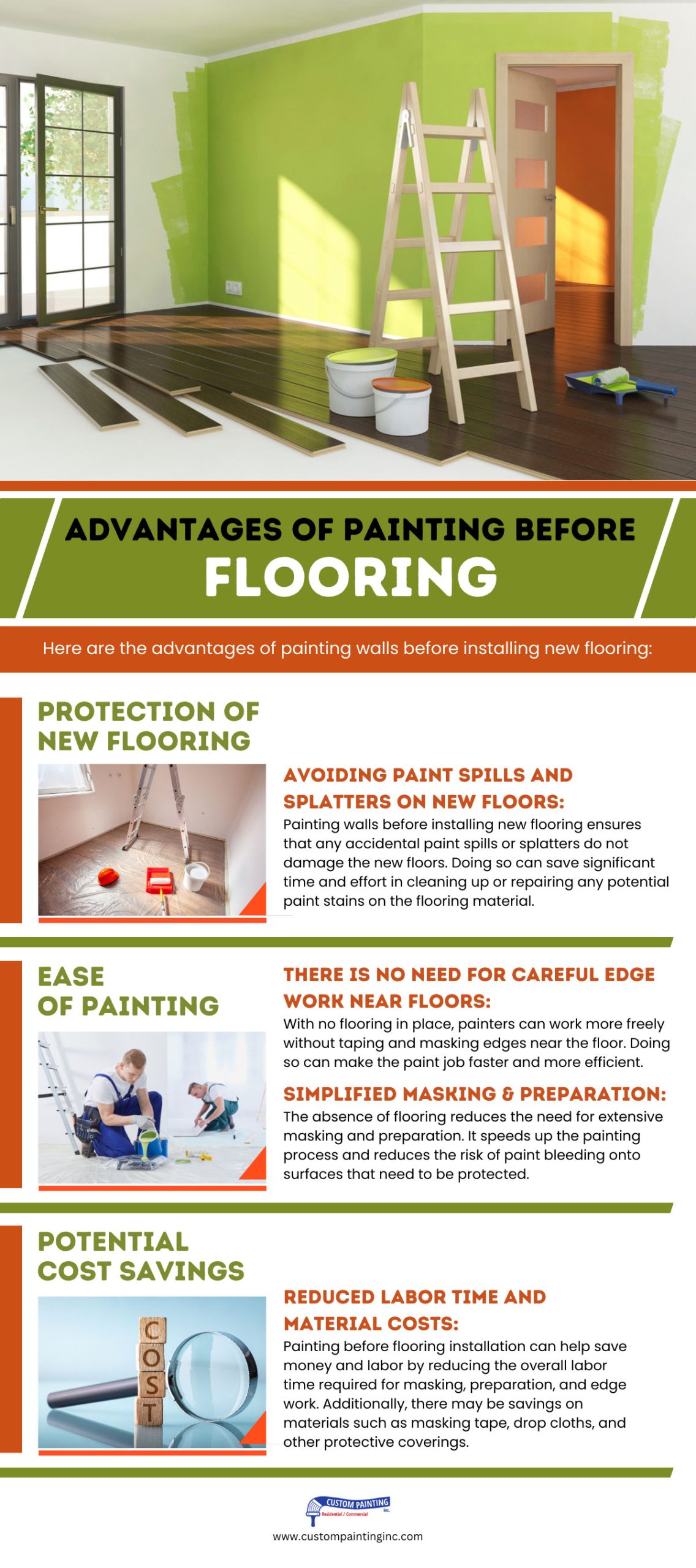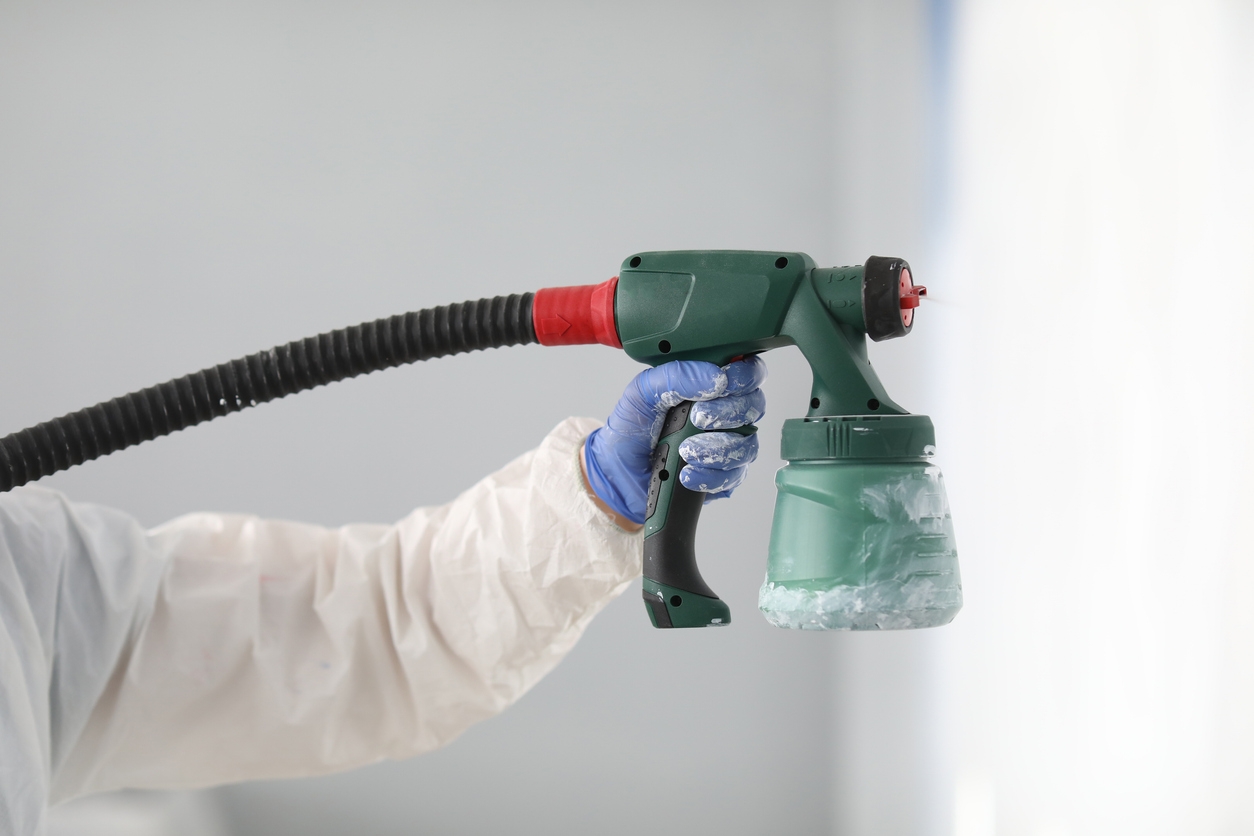Home renovation projects in the San Ramon, CA area often involve multiple tasks to improve a home’s aesthetic and functional aspects. Usual projects include painting walls, installing new flooring, updating kitchens and bathrooms, and enhancing overall interior design.
A frequent question during renovations is whether to paint the walls before or after installing new flooring. This decision can impact the overall efficiency and cleanliness of the renovation process.
If you’re looking for answers to that question, this article will guide you on the optimal timing for painting walls relative to installing new flooring. It aims to help homeowners make informed decisions to achieve the best results in their renovation projects.
Factors to consider
When planning painting and flooring projects, consider several critical factors that ensure your project’s efficiency and success. Here is a detailed discussion of the factors to consider:
Project scope
The size and complexity of painting and flooring projects
Painting projects:
- Size of the area: Determine the total square footage to be painted, including walls, ceilings, and trim.
- Number of rooms: Identify how many rooms or areas need painting, as this will affect the time and resources required.
- Surface condition: Assess the current condition of the surfaces you’ll paint. Walls with damage, old paint, or wallpaper will require more preparation. Also consider if you need to do wallpaper removal as well.
- Color and finish: Decide on the colors and finishes (e.g., matte, satin, gloss) for each area. It will influence the type and amount of paint needed.
- Access and safety: Consider how easily the painting areas can be accessed. High ceilings, stairwells, and exterior surfaces may require special equipment and safety measures.
- Timeline: Establish a realistic timeline for the project, considering any drying times between coats of paint.
Flooring projects:
- Square footage: Measure the total area that requires new flooring. It will determine the amount of material needed.
- Subfloor condition: Evaluate the condition of the existing subfloor to ensure it is suitable for the new flooring type. Repairs or leveling may be necessary.
- Room function: Consider the function of the room(s) being floored. High-traffic areas, kitchens, and bathrooms have different requirements than bedrooms or living rooms.
- Installation complexity: Some flooring types are more complex to install than others, requiring specialized tools and skills.
Type of flooring
Hardwood, laminate, carpet, tile, etc.
Hardwood flooring:
- Material: Different types of wood (oak, maple, cherry, etc.) offer varying hardness, durability, and aesthetic qualities.
- Finish: Prefinished or unfinished wood, with options for staining and sealing.
- Installation: Requires precise cutting and fitting, with considerations for expansion gaps.
- Maintenance: Needs regular maintenance, such as refinishing and cleaning to maintain its appearance.
Laminate flooring:
- Cost: Generally more affordable than hardwood while offering a similar look.
- Durability: Resistant to scratches, moisture, and wear, making it suitable for high-traffic areas.
- Installation: Often comes with click-lock systems for easier installation.
- Underlayment: Requires a proper underlayment to reduce noise and provide cushioning.
Carpet flooring:
- Material: Available in various materials such as nylon, polyester, wool, and blends, each with different comfort levels, durability, and stain resistance.
- Pile type: Cut pile, loop pile, or a combination, affecting the texture and appearance.
- Padding: Quality padding is essential for comfort and longevity.
- Maintenance: Carpet flooring requires regular vacuuming and occasional deep cleaning to maintain hygiene and appearance.
Tile flooring:
- Material: Options include ceramic, porcelain, natural stone (marble, granite, slate), and glass. Each material has unique properties and aesthetics.
- Grout: The color and type of grout can significantly affect the overall look and maintenance.
- Water resistance: Ideal for moisture-prone areas, such as kitchens and bathrooms.
- Installation: Requires precise measurements and cutting, and professional installation is often recommended.
Additional considerations
- Budget: The cost of painting and flooring projects can vary significantly. It’s important to establish a budget that includes materials, labor, and additional expenses for preparation and cleanup.
- Material quality: Higher-quality paints and flooring materials may have a higher upfront cost but can offer better durability and long-term satisfaction.
- Environmental impact: Consider eco-friendly options such as low-VOC paints and sustainable flooring materials.
- Professional vs. DIY: Decide whether to hire professionals or tackle the projects yourself. Professional services can offer expertise and efficiency but at a higher cost.
- Permits and regulations: Check local building codes and regulations to ensure compliance, especially for larger or structural changes.
By carefully considering these factors, you can plan and execute painting and flooring projects more effectively, resulting in a finished product that meets your aesthetic, functional, and budgetary goals.
Advantages of painting before flooring

Protection of new flooring
- Avoiding paint spills and splatters on new floors: Painting walls before installing new flooring ensures that any accidental paint spills or splatters do not damage the new floors. Doing so can save significant time and effort in cleaning up or repairing any potential paint stains on the flooring material.
Ease of painting
- There is no need for careful edge work near floors: With no flooring in place, painters can work more freely without taping and masking edges near the floor. Doing so can make the paint job faster and more efficient.
- Simplified masking and preparation: The absence of flooring reduces the need for extensive masking and preparation. It speeds up the painting process and reduces the risk of paint bleeding onto surfaces that need to be protected.
Potential cost savings
- Reduced labor time and material costs: Painting before flooring installation can help save money and labor by reducing the overall labor time required for masking, preparation, and edge work. Additionally, there may be savings on materials such as masking tape, drop cloths, and other protective coverings.
Advantages of painting after flooring
Here are the advantages of painting walls after installing new flooring
Accurate color coordination
- Matching paint color to the new flooring: Once the new flooring is installed, it’s easier to choose a paint color that complements or matches it. This ensures a cohesive and harmonious look in the room.
Final touch-up
- Addressing any wall damage caused during flooring installation: The installation of new flooring can sometimes cause minor damage to walls, such as scuffs, scratches, or dents. Painting afterward lets you cover up these imperfections and achieve a pristine finish.
Cleaner installation process
- Avoiding dust and debris from flooring installation affecting freshly painted walls: Installing flooring can be messy, generating dust and debris that could settle on newly painted walls. Painting after the flooring installation lets you avoid the risk of dirt or damage to the new paint job, ensuring a cleaner, more polished result.
Additionally, painting after flooring installation allows:
Edge precision
- Painters can achieve a more precise edge where the wall meets the floor, ensuring a neat and professional finish without worrying about protecting the new flooring from paint splatters or spills.
Furniture placement
- If you’re updating furniture or room layout along with flooring, you can consider the overall aesthetic once the flooring is in place and adjust the paint color accordingly.
These considerations help ensure the room’s final look is cohesive, polished, and professionally done.
Potential challenges and solutions
When installing new flooring and painting, several challenges can arise, but with proper planning and techniques, these can be managed effectively. Here are the potential challenges and their solutions:
Dealing with dust and debris
Challenges:
- Dust and debris can contaminate the paint and flooring surfaces.
- It can be challenging to keep the area clean during the process.
Solutions:
- Effective cleaning and preparation methods:
-
- Preparation: To contain the dust, seal off the work area with plastic sheeting. Use drop cloths to protect surfaces.
- Cleaning: Use a HEPA vacuum to clean up dust and debris frequently. Wet-dry vacuums can be effective for larger debris.
- Air filtration: Utilize air scrubbers or portable air filtration units to reduce airborne dust.
- Surface cleaning: Wipe down surfaces with a damp cloth before painting or installing flooring to ensure they are dust-free.
Managing timelines and schedules
Challenges:
- Coordinating different contractors and project stages can be complex.
- Delays in one stage can affect the entire project timeline.
Solutions:
- Coordinating different contractors and project stages:
-
- Planning: Create a detailed project plan with timelines for each stage. Use project management software to keep track of progress.
- Communication: Maintain regular communication with all contractors. Schedule weekly or bi-weekly meetings to discuss progress and address any issues.
- Buffer time: Plan for buffer time between stages to account for unforeseen delays.
- Overlap tasks: When it is possible, overlap tasks that don’t interfere with each other to save time. For example, paint one room while flooring is being installed in another.
Handling touch-ups
Challenges:
- The flooring installation process can damage painted walls.
- Touching up paint can be tricky, especially if the paint has cured and doesn’t blend well.
Solutions:
- Tips for touching up paint after flooring installation:
-
- Protective measures: Use painter’s tape along the baseboards and plastic sheeting to protect walls during flooring installation.
- Touch-up paint: Keep extra paint from the original job for touch-ups. Store it properly to prevent it from drying out or changing color.
- Blending: Use a high-quality brush or roller to blend the touch-up paint with the existing paint. Feather the edges to avoid a noticeable difference.
- Spot cleaning: Before doing the touch-ups, clean any scuffs or marks on the walls with a mild detergent and water.
Addressing these challenges with proactive solutions can ensure a smoother installation process and achieve a professional finish for flooring and painting projects.
Conclusion
One of the common questions in home improvement is whether to paint before or after installing new flooring. Choosing the best approach depends on your circumstances, personal preference, and other factors, such as your project’s scope and the type of flooring type you’ll install.
For example, if you don’t want stains on your newly installed floor, paint the walls. Or, if you coordinate colors in your room, install the flooring before painting the walls. For large-scale renovations, painting first can prevent potential damage to new floors. However, for flooring like carpet, painting after installation may be preferable.
Consider your project needs and seek professional advice to ensure the best outcome. For expert assistance, contact our skilled and seasoned paint crew from Custom Painting, Inc. to help guide you through the process. Call us at 925-866-9610 or message us on our online contact form for a free job estimate.



